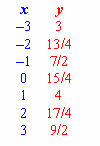The 1st degree equations that present only one unknown respect the following general form: ax + b = 0, with a ≠ 0 and variable x. 1st degree equations with two unknowns present a different general form, as they depend on two variables, x and y. Note the general form of this type of equation: ax + by = 0, with a ≠ 0, b ≠ 0 and variables forming the ordered pair (x, y).
In the equations where the ordered pair exists (x, y), for each value of x we have a value for y. This occurs in different equations, since from equation to equation the numerical coefficients a and b assume different values. Take a look at some examples:
Example 1
Let's build a table of ordered pairs (x, y) according to the following equation: 2x + 5y = 10.
x = –2
2 * (–2) + 5y = 10
–4 + 5y = 10
5y = 10 + 4
5y = 14
y = 14/5
x = -1
2 * (–1) + 5y = 10
–2 + 5y = 10
5y = 10 + 2
5y = 12
y = 12/5
x = 0
2 * 0 + 5y = 10
0 + 5y = 10
5y = 10
y = 10/5
y = 2
x = 1
2 * 1 + 5y = 10
2 + 5y = 10
5y = 10 - 2
5y = 8
y = 8/5
Do not stop now... There's more after the advertising ;)
x = 2
2 * 2 + 5y = 10
4 + 5y = 10
5y = 10 - 4
5y = 6
y = 6/5
Example 2
Given the equation x – 4y = –15, determine the ordered pairs obeying the numerical range –3 ≤ x ≤ 3.
x = –3
–3 – 4y = – 15
– 4y = –15 + 3
– 4y = – 12
4y = 12
y = 3
x = – 2
–2 – 4y = – 15
– 4y = –15 + 2
– 4y = – 13
4y = 13
y = 13/4
x = – 1
–1 – 4y = – 15
– 4y = –15 + 1
– 4y = – 14
4y = 14
y = 14/4 = 7/2
x = 0
0 – 4y = – 15
– 4y = – 15
4y = 15
y = 4/15
x = 1
1 – 4y = – 15
– 4y = – 15 – 1
– 4y = – 16
4y = 16
y = 4
x = 2
2 – 4y = – 15
– 4y = – 15 – 2
– 4y = – 17
4y = 17
y = 17/4
x = 3
3 – 4y = – 15
– 4y = – 15 – 3
– 4y = – 18
4y = 18
y = 18/4 = 9/2 
by Mark Noah
Graduated in Mathematics
Would you like to reference this text in a school or academic work? Look:
SILVA, Marcos Noé Pedro da. "Equation of the 1st degree with Two Unknowns"; Brazil School. Available in: https://brasilescola.uol.com.br/matematica/equacao-1-o-grau-com-duas-incognitas.htm. Accessed on June 28, 2021.



